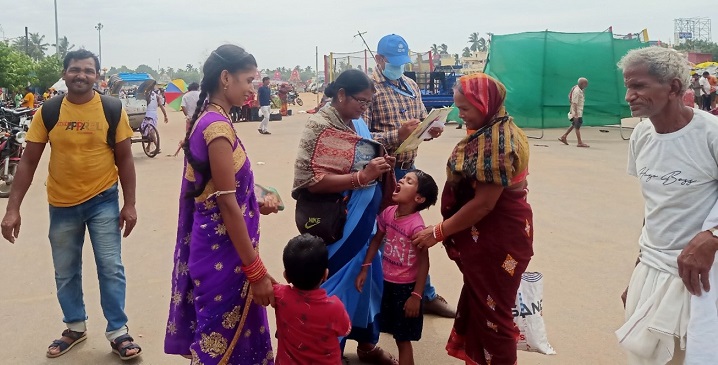India reported the last case of polio on 13 January 2011, but continues to immunize children under five years against polio as part of routine immunization and on National/Sub-National Immunization Days (NIDs/SNIDs) to maintain a high level of population immunity. For early case detection, India simultaneously conducts high-quality acute flaccid paralysis surveillance supplemented with environmental surveillance, which involves regular collection and testing of sewage samples from selected sites from across the country to detect polio virus in faecal matter. Environmental surveillance detects polio even in people who do not present with symptoms.
With over 1.5 million devotees from across the country congregating in the coastal temple town of Puri in Odisha for nine days to participate in Shri Jagannath Rath Yatra festivities in June 2023, District Health Department planned and implemented a four-day Special Polio Vaccination Campaign in 20 sites to vaccinate all children under the age of 5 years. The Odisha state government allocated 30 000 doses of the polio vaccine from state stocks, which were used to vaccinated 7621 children in the 0-5 years age group at the major transit points, mela grounds (fairgrounds), and bazaars (community markets).

ASHAs vaccinating children against polio during Special Vaccination Campaign in Puri on
27 June 2023 (Photo: Swati Smrutimayi Sahoo/ © WHO India)
Shri Jagannath Rath Yatra is one of the biggest religious and cultural gatherings in the world, when devotees pull three massive handcrafted wooden chariots of Lord Jagannath, his brother Lord Balabhadra, and sister Devi Subhadra through the streets of Puri. Devotees believe that a glimpse of the gods in their chariots or touching the ropes pulling the chariots, leads to moksha – freedom from the cycle of life and death.
At the request of the Odisha state government, WHO India-National Public Health Support Network (NPSN) provided support in planning and supportive supervision to ensure quality coverage. WHO India-NPSN also provided support in planning the session site locations, including orientation of vaccinators and field monitors for supportive supervision during the special polio vaccination drive on all four days.

A WHO India-National Public Health Support Network field monitor at the vaccination site to
ensure quality coverage (Photo: Nihar Ray/ © WHO India)
The vaccination drive recorded high quality vaccination coverage. Independent monitoring assessment supported by WHO-NPSN showed that:
- 93% (n=126) children found checked for finger marking by transit point teams
- 100% (n=107) children vaccinated without the dropper touching the child’s mouth
- 100% (n=20) transit points had teams deployed in adequate numbers
- 95% (n=20) transit points had deployed persons present at site
- All vaccine vials found at usable stage (no unused/partially used vaccine vial monitor found)
WHO India-NSPN field teams independently monitor vaccination sessions and conduct community assessment of coverages, including reasons for vaccinations being missed. Monitoring data at subnational levels is used to prioritize customized vaccination strategies and operational plans to address immunization gaps. WHO India also assists the national and state governments in capacity building, identification and coverage of high risk and low performing areas, monitoring and data analysis, and advocacy for implementation of evidence-based corrective actions.
